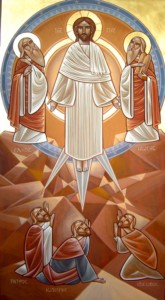“Charm is deceitful, and beauty is vain.”–Proverbs 31: 30a
“Through delight in the beauty of these things they assumed them to be gods.”–Wisdom 13: 3
As I develop the theme of beauty as a revelation of God, it is important to offer some clear theological foundations. Providentially, the Church has provided exactly the right Mystery for this task today, the Feast of the Transfiguration. Let me take this opportunity to name the themes I intend to convey in the coming posts, and how they are explained by the Transfiguration. As the two opening quotes attest, the Bible gives us an ambiguous presentation of beauty. Beauty seduces when misappropriated. The Church’s tradition also teaches that it conduces to holiness, under the right circumstances.
Beauty is Incarnate. God clothes Himself in a body, but this body is precisely what conveys to Peter, James, and John the splendid divinity of the wearer. God communicates through physical signs, and manifests Himself in the material world, as He did in the pillar of cloud and fire.
Beauty is both lucid and opaque. “A bright cloud overshadowed them [Matthew 17: 5].” This image is paradoxical; the cloud is apparently a bright shadow. It is parallel to the sign of God’s presence at the crucial moment of the Exodus: “the Lord in the pillar of fire and of cloud looked down upon the host of the Egyptians [Exodus 14: 24].” This paradox is connected to the “cascade of mysteries” to which I referred in my opening post. Just when a beautiful object seems crystal-clear, it can suddenly appear strange.
Beauty gives us hope by revealing God’s nearness and His ultimate triumph. In a seventh-century homily, Saint Anastasius of Sinai writes, “It was as if [the Lord] said to them, ‘As time goes by you may be in danger of losing your faith.’” To save us from this, the Lord revealed His glory on Mount Tabor. Through the gift of the Holy Spirit, we are now able to hear (or read) all languages–including the language of creation, the natural world–in our own vernacular. “The Lord is at hand! Have no anxiety about anything [Philippians 4: 5-6].”
Beauty gives us hope by revealing our destiny of glory. “Our commonwealth is in heaven, and from it we await a Savior, the Lord Jesus Christ, who will change our lowly body to be like his glorious body [Philippians 3: 20-21].” The Transfiguration is a foreshadowing of what will happen to our bodies, and the bodies of all creatures, when God becomes all in all [cf. 1 Corinthians 15: 21], and “the earth will be filled with the knowledge of the glory of the Lord, as the water covers the sea [Habakkuk 2: 14].”
Beauty demands a moral response. “Jesus came and touched them, saying, ‘Rise, and have no fear [Matthew 17: 7].’” The Apostles had fallen, death-like, on their faces, aware of their smallness beside God’s glory, but the Lord commands them to rise and to continue on their way with Him.

Saint John of the Cross, one of the great poets of the Spanish language, possessed a delicate sense of beauty. He grew in sanctity and earned that sense of beauty through an eight month ordeal of solitary confinement.
Our glorious destiny is by the Way of the Cross. Jesus commands them not to tell anyone what they have seen until the Son of Man is raised from the dead. The full realization of the Transfiguration is reserved for the Resurrection [N.B. Jesus’s appearance after the Resurrection is often “opaque”!]. Beauty is apt to be misunderstood and misappropriated if we desire it without renunciation.
We will recognize the true beauty in all creatures to the extent that our moral response to beauty is a cruciform renunciation. This summarizes the last few points, and it adds one last dimension. It is true that beauty can be seductive, and therefore poses a spiritual danger to us. We can combat this danger by renunciation. There are various ways of going about this. Saint John of the Cross gives us a rule of thumb: if we encounter something beautiful and immediately think of God, it’s safe. Otherwise, we probably need to grow in the virtue of temperance, and specifically in the subvirtue of chastity. By meditation on the Cross, we can learn to be detached from all creatures. The reward of this detachment is that we will come to see all creatures no longer as material for us to possess and manipulate, but as sacraments of God’s presence.
